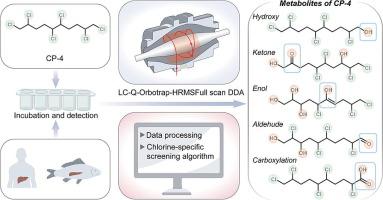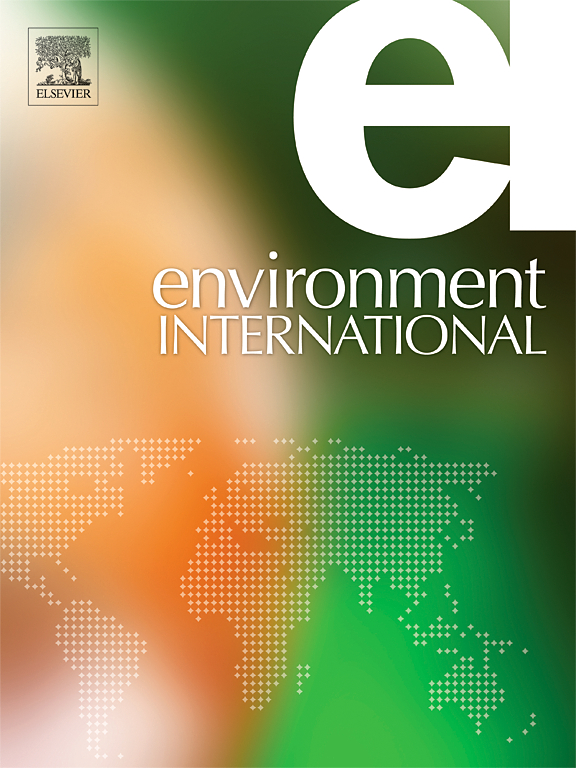A comprehensive characterization biotransformation of chlorinated paraffin by human and carp liver microsomes via liquid chromatography-high-resolution mass spectrometry and screening algorithm
IF 9.7
1区 环境科学与生态学
Q1 ENVIRONMENTAL SCIENCES
引用次数: 0
Abstract
The chlorinated paraffin (CP) monomer 1,2,5,6,9,10-Hexachlorodecane (CP-4) was subjected to in vitro biotransformation using human and carp liver microsomes. Five types of CP-4 metabolites (OH–, keto-, enol-, aldehyde- and carboxy-CP-4) were identified in human liver microsomer while only mono-OH-CP-4 was found in the carp liver microsomes. Kinetic studies revealed that the formation of mono-, di-, tri-hydroxylated CP-4, keto-, enol-, and aldehyde-CP-4 in human liver microsomes was best described by substrate inhibition models, whereas the formation of carboxylated CP-4 metabolites best fit the Michaelis–Menten model. Notably, keto-CP-4, enol-CP-4 and aldehyde-CP-4 were the predominant metabolites. The estimated Vmax values for these metabolites were significantly higher in the human liver microsomes than in the carp liver microsomes. The intrinsic hepatic clearance (CLint) of CP-4 was higher in humans than in carp, indicating species-specific differences in its metabolism. This study also highlighted potential toxicity concerns, with computational predictions showing varying degrees of acute oral toxicity for CP-4 and its metabolites. These findings indicate significant species-specific differences in the biotransformation of CP-4, emphasizing the potential health and environmental risks associated with chlorinated paraffins and their metabolites, and underscore the need for further research to address these concerns.


采用液相色谱-高分辨率质谱法和筛选算法对人类和鲤鱼肝微粒体对氯化石蜡的生物转化进行了全面表征
采用人、鱼肝微粒体对氯化石蜡(CP)单体1,2,5,6,9,10-六氯癸烷(CP-4)进行体外生物转化。在人肝微粒体中鉴定出5种类型的CP-4代谢物(OH -、酮-、烯醇-、醛-和羧基-CP-4),而在鲤鱼肝微粒体中只发现一种OH-CP-4。动力学研究表明,人肝微粒体中单羟基、二羟基、三羟基CP-4、酮基、烯醇基和醛基CP-4的形成最适合底物抑制模型,而羧基CP-4代谢物的形成最适合Michaelis-Menten模型。主要代谢物为酮- cp -4、烯- cp -4和醛- cp -4。这些代谢物的Vmax值在人肝微粒体中显著高于鲤鱼肝微粒体。人体内CP-4的内在肝脏清除率(CLint)高于鲤鱼,表明其代谢存在物种特异性差异。该研究还强调了潜在的毒性问题,计算预测显示CP-4及其代谢物具有不同程度的急性口服毒性。这些发现表明CP-4的生物转化存在显著的物种特异性差异,强调了与氯化石蜡及其代谢物相关的潜在健康和环境风险,并强调需要进一步研究以解决这些问题。
本文章由计算机程序翻译,如有差异,请以英文原文为准。
求助全文
约1分钟内获得全文
求助全文
来源期刊

Environment International
环境科学-环境科学
CiteScore
21.90
自引率
3.40%
发文量
734
审稿时长
2.8 months
期刊介绍:
Environmental Health publishes manuscripts focusing on critical aspects of environmental and occupational medicine, including studies in toxicology and epidemiology, to illuminate the human health implications of exposure to environmental hazards. The journal adopts an open-access model and practices open peer review.
It caters to scientists and practitioners across all environmental science domains, directly or indirectly impacting human health and well-being. With a commitment to enhancing the prevention of environmentally-related health risks, Environmental Health serves as a public health journal for the community and scientists engaged in matters of public health significance concerning the environment.
 求助内容:
求助内容: 应助结果提醒方式:
应助结果提醒方式:


